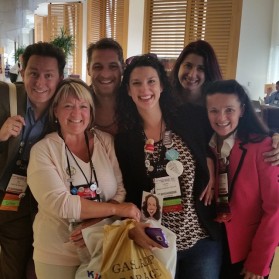Joy details the trials and tribulations of its titular hero, a person with an agile and inventive mind, finding herself stymied by a motley assemblage of “adversaries” (and allies) in “commerce,” many of whom arrive in the guise of earnest or envious (or both) family members. Joy sees commercial opportunities in the mundane – a reflective, choke-free flea-collar here, a hands-free mop there – but the patriarchal world she inhabits marginalizes her gifts while simultaneously pirating her ingenuity. Tale as old as time …
Jennifer Lawrence, joining Russell for their third collaboration after her Oscar win in his Silver Linings Playbook and her nomination for his American Hustle, is utterly transfixing in her most believable turn to date. The film’s and Lawrence’s chief gift is how normal all the abnormal seems; Lawrence (and, by extension, the audience) lives Joy’s life, finding laughter and poignancy and tears where all of us find those things: family gatherings, business meetings, arguments with spouses, reading a story to our children, trying to convince a stranger to take a chance on an idea.
Some may (and will) argue with me, but this is the most feminist set of cinematic ideas to come down the pike in a while. Yes, Joy is inventing a mop, a symbol to some of domestic oppression, but, in the act of transforming its utility, she reclaims this symbol as her own. Her journey to get her thoughtfully designed functionality in the hands of other like-minded consumers becomes a hero’s quest, tilting at male-dominated windmills of finance, retail, media, manufacturing, and legal contracts. It’s not a showy role. Her turns in Silver Linings or American Hustle gave her many more cracked P.O.V. tics with which to play, but, in this film, Lawrence is all the better for Joy’s absence of quirk.
The surety with which Joy moves through life can seem nebulous at times. We are introduced to her as a little girl who empirically states that “I don’t need a prince.” That is the constant in her life, but she isn’t a volatile trail blazer either. She is a Valedictorian with a caretaker’s spirit, leveraging the strength (and madness) of the family and friends and opposition around her, quietly and calmly observing the world as it is and periodically dashing forth to change how it could be. It’s a masterful, nuanced performance.
Lawrence is aided and abetted by what is quickly becoming Russell’s version of Orson Welles’ Mercury Players, a stellar repertory supporting cast that includes Russell vets Robert DeNiro as Joy’s time-warped fiend of a father, Bradley Cooper as a slick television producer with a heart of gold, and Elisabeth Rohm as Joy’s meddlesome sibling rival, alongside newcomers Virginia Madsen as Joy’s sparkling kook of a soap opera obsessed mom, Diane Ladd as Joy’s fairy godmother/grandmother, Isabella Rossellini as DeNiro’s moneyed girlfriend and Joy’s snake-skinned benefactor, Dascha Polanco as Joy’s steadfast pal and confidante, and Edgar Ramirez as Joy’s charming ex-husband and trusted consigliere. Susan Lucci and Donna Mills even pop up in a couple of brilliantly gaga cameos.
My husband John says that his test of a good film is if it “takes him somewhere” and makes him feel as if he is there in that place and time, living the moments with the characters onscreen. I mentioned this to my parents as we were leaving the theatre, and we all agreed that, by that criteria, this is a perfect film.
Alas, we were less enamored of Joy‘s Christmas 2015 box office “adversary in commerce” The Big Short, equally an ensemble piece packed with star power but falling far short (pun intended) of Joy‘s exquisite music box pathos. The Big Short, directed by Adam McKay (Anchorman, Talladega Nights) from the book by Michael Lewis, fancies itself a bold hybrid of Ocean’s Eleven‘s ring-a-ding boy band swagger and Michael Moore’s progressively incendiary documentarian instincts.Unfortunately, it’s neither. Jennifer Lawrence has more swagger in one confrontation with some misogynistic QVC middle managers, than Christian Bale, Steve Carell, Ryan Gosling, Brad Pitt, Finn Wittrock, or John Magaro manage collectively against monolithic Wall Street through the entirety of The Big Short. (Hamish Linklater, Rafe Spall, and Jeremy Strong as Carell’s bullpen of hedge-fund managing second bananas do have some firecracker moments, but they are few and far between.) Melissa Leo puts in a sharp appearance as a ratings agency employee who happily, if improbably, exposes the game afoot when even the guardians at the gate will play for pay.
The film attempts to explicate for us common folk the ins and outs of the housing market collapse in 2008. McKay has been on record as saying this is the most important story of our time and that his film will make crystal clear the who, what, how, and why so that any audience member will understand what transpired. Wrong.
McKay, alongside co-screenwriter Charles Randolph, has given us Wolf of Wall Street-lite, with a mess of characters messily drawn, offering the sketchiest of backgrounds. Hey, Christian Bale’s former MD Michael Burry is a financial savant. Know why? ‘Cause he wears no shoes and plays the air drums while listening to death metal in his rent-by-the-hour office. Oh, Steve Carell’s Mark Baum lost a brother to suicide so he’s all angst-ridden now, wanting to topple the very financial system that still provides his daily income … so he’s noble, but broken. Get it? Brad Pitt’s Ben Rickert gave up this seedy Wall Street live for the noble world of organic gardening – see, he’s going to make something … from the earth. And on and on.
Each character shows up like they are going to enter the road race from It’s a Mad, Mad, Mad, Mad World without any of the wit, the charm, or, heaven help us, the plot.
McKay does little to ground us in why we should care about any of this, other then some clunky asides that are meant to be Funny or Die! camp, randomly inserting celebrities like Margot Robbie in a bubble bath (fire your agent, Robbie!), Anthony Bourdain making fish chowder, or Selena Gomez at a roulette wheel. In that, “aren’t we in-crowd cute?” way, these Fantasy Island castaways turn to the camera, ostensibly simplify some complex economic concept (which ends up more confusing than ever), wink, and then turn back to whatever insipid task before them. It just doesn’t work. And it’s annoying. McKay seems to want it both ways: take this topic very seriously, but don’t mind while we make fun of said topic like sophomoric smart asses.
There was an interesting film here. This isn’t it. I’m not sure McKay’s politics got in the way of making a focused, coherent film, as I’m not sure after watching The Big Short what those politics might even be. Only Ryan Gosling and, to a lesser degree, Christian Bale escape unscathed.
Gosling and Bale seem like they are in another movie entirely (probably once they realized the script was an incoherent mess, they started dog paddling for any port in the storm). Gosling sparkles as the film’s narrator, embracing his fourth-wall-breaking conceit with wry, near-Shakespearean aplomb. He’s a hoot to watch. Bale is less delightful but an oddly thundering presence, a man-child thumbing his nose at a financial system (and likely a film) that ultimately doesn’t appreciate (nor deserve) his superhuman talents.
Like Joy, there was something to be said in The Big Short about a society that worships the almighty dollar above integrity, kindness, and humanity. Where Joy weaves an inspiring yet delicate fable of victory over a cruel and unkind system, The Big Short becomes mired in its own smug condescension, victim to the very machine it aims to skewer.
_________________
Enjoy these cards (handmade by my dad Don Sexton) and these photos of us enjoying the whimsical presents given by my mom Susie Sexton. We had such a wonderful holiday weekend – I hope you did too!











Reel Roy Reviews is now TWO books! You can purchase your copies by clicking here (print and digital). In addition to online ordering at Amazon or from the publisher Open Books, the first book is currently is being carried by Bookbound, Common Language Bookstore, and Crazy Wisdom Bookstore and Tea Room in Ann Arbor, Michigan and by Green Brain Comics in Dearborn, Michigan. My mom Susie Duncan Sexton’s Secrets of an Old Typewriter series is also available on Amazon and at Bookbound and Common Language.








 Reel Roy Reviews is now TWO books! You can purchase your copies by clicking
Reel Roy Reviews is now TWO books! You can purchase your copies by clicking 







 Thanks to Gail Lamarche and the
Thanks to Gail Lamarche and the  You can’t just gather up an army of digital acolytes and hope something magical happens in order to promote your service or to achieve your desired business outcomes. You have to engage these people in meaningful ways that add value to their daily lives. As in life, a social media relationship is a transaction. It can be small – making sure you acknowledge a client/co-worker/colleague birthday – or big – writing a killer blog post that gives great analysis on a developing legislative issue or case victory.
You can’t just gather up an army of digital acolytes and hope something magical happens in order to promote your service or to achieve your desired business outcomes. You have to engage these people in meaningful ways that add value to their daily lives. As in life, a social media relationship is a transaction. It can be small – making sure you acknowledge a client/co-worker/colleague birthday – or big – writing a killer blog post that gives great analysis on a developing legislative issue or case victory. 



 Roy earned his Bachelor’s degree from
Roy earned his Bachelor’s degree from ![[Image Source: Wikipedia]](https://reelroyreviews.files.wordpress.com/2015/12/the-wiz-live.jpg?w=193&h=300)
